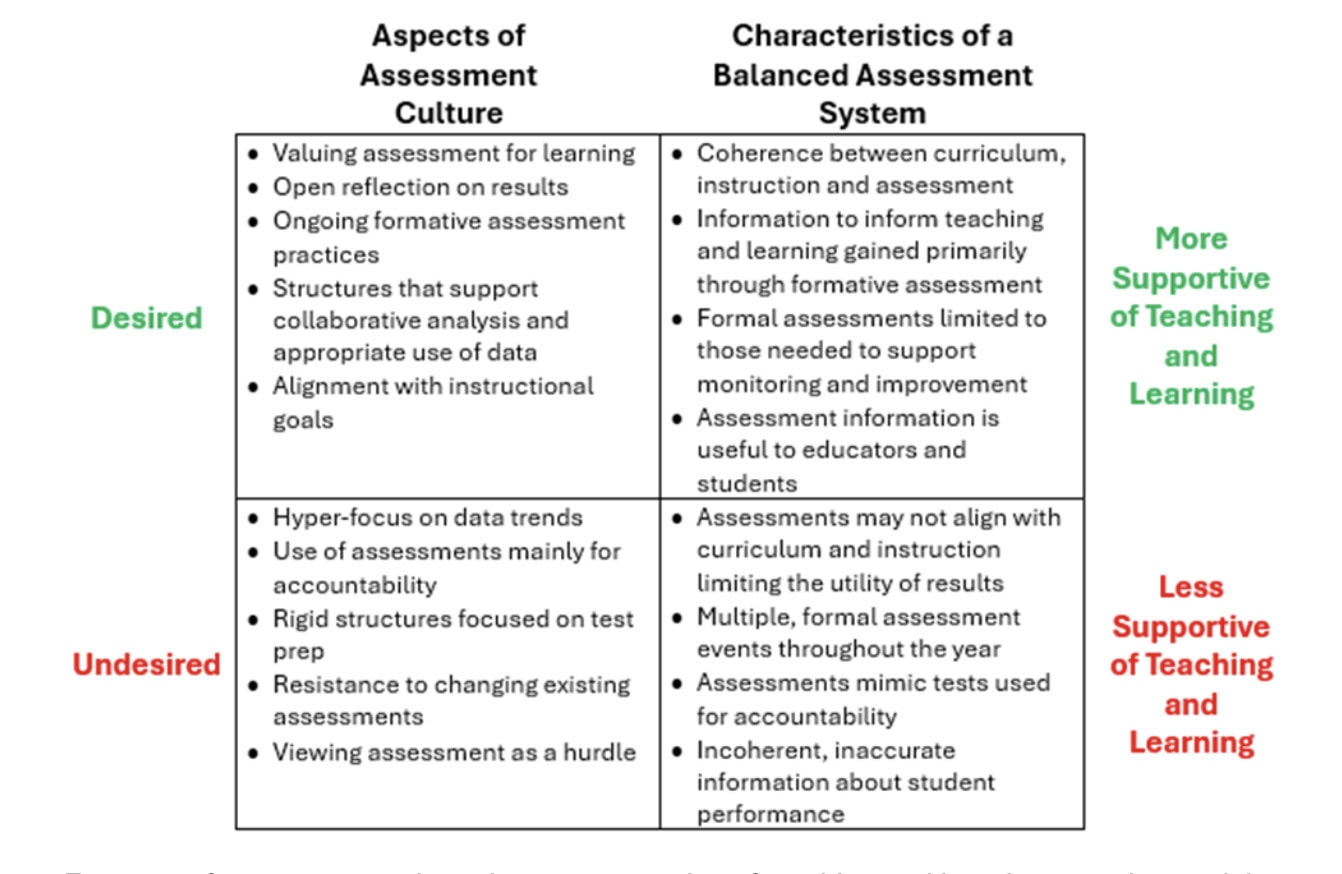
Assessment Culture and Assessment Systems
How working to improve one can improve the other
Which came first: the chicken or the egg? People repeat this eternal question when they’re trying to unravel how something came to be. And it’s a question we ask frequently when we’re considering assessment systems and assessment culture. Should we focus on improving the culture so we can make a positive impact on the system, or vice versa? We believe the answer is a double yes: We should work on both.
Assessment Culture’s Relationship to School Culture
A large body of research has examined school culture and its impact on policies, practices, interpersonal relationships and educational outcomes. School culture is typically defined as the expectations, beliefs, values and assumptions that shape the activities of the personnel and students in a school.
In practice, culture shows up in the little things we often take for granted. It’s in how classrooms are organized; how educators, students and families interact, how success is defined and celebrated, and even in the displays on a school’s hallway bulletin boards.
Viewed through a different lens, these things can reveal something about a school’s assessment culture. We define assessment culture as the collective expectations, values, and beliefs a school community has about the role, value and purpose of assessment.
How Assessment Culture Shows Up in Schools
The notion of an assessment culture originated from Lorrie Shepard’s groundbreaking article, “The Role of Assessment in a Learning Culture.” Like school culture, a school’s assessment culture is revealed in the way educators select or design assessments, how they discuss the purpose of different types of assessment, and the amount of time students spend preparing for or taking tests.
It shows up in the ways parents and students talk about assessment results, what they believe results mean, how results are communicated and the structures in place to support educators’ understanding and use of assessment processes and results. Assessment culture is shaped by the broader school culture and by the individual experiences and predispositions of educators, leaders, students, and community members.
Culture impacts systems, and systems impact culture.
We believe that assessment culture plays a powerful role in shaping efforts to modify assessment systems. In particular, examining a school’s assessment culture can help identify factors that can inhibit efforts to develop more balanced assessment systems and illuminate strategies to address them.
Impact of Assessment Culture
Taking time to understand a school or district’s assessment culture is essential because it reveals the beliefs and values that influence assessment decisions—decisions that can unintentionally support or constrain the move toward more balanced systems of assessment.
For example:
- A school that believes trend data must be maintained at all costs (e.g., giving a specific assessment to all students three times per year no matter what other assessment information is available) may prioritize assessment continuity over efficiency, quality, or alignment.
- A school that values assessment as a tool for learning is more likely to invest in professional development focused on formative assessment practices than in strategies to boost interim or summative results.
- A school that uses assessment to control behavior (e.g., student data walls) is more likely to equate assessments with events to prepare for, or grades, rather than opportunities for reflection and understanding.
Research has shown that school reforms are unlikely to succeed if they conflict with one or more of the underlying assumptions, such as those listed above, that shape a school’s culture. In many cases, these assumptions and their influence remain hidden until they are intentionally surfaced. This suggests that if districts and schools are to make meaningful and lasting improvements to their assessment systems, they must first identify and address the assumptions and predispositions that may hinder progress.
Relationship With Balanced Assessment Systems
Creating assessment systems that demonstrate coherence, efficiency, utility, and the other characteristics associated with balanced assessment systems is no small feat. Addressing gaps in assessment literacy, policy dynamics, the impact of commercialization and other factors that drive assessment decisions requires more than professional development. It demands a thoughtful strategy for assessment system change—one that identifies and addresses the cultural factors that sustain the current state.
The figure below illustrates how aspects of assessment culture (left column) and characteristics of balanced assessment systems (right column) are interconnected. The top row represents desired conditions that support teaching and learning, while the bottom row shows conditions that can undermine improvement.

Features of assessment culture that are supportive of teaching and learning— such as valuing assessment for learning and having clear structures in place to support collaborative analysis—facilitate the likelihood that desired characteristics of a balanced assessment system, as represented in the top right cell, will be observed.
In contrast, hindering aspects of assessment culture—such as a narrow focus on data trends, the use of assessment results primarily for accountability, and rigid structures focused on test prep—make it more likely that an assessment system will be less balanced as characterized by incoherence, limited instructional utility and other features represented in the bottom right cell.
The relationship between assessment culture and balanced assessment systems is bidirectional (purple arrow) because the tools and activities necessary to move a system toward balance should reinforce a supportive assessment culture in the same way improving assessment culture should provide for greater balance.
For example, conducting a thoughtful assessment system audit requires educators to carefully interrogate the components of their existing assessment system for efficiency, utility, and coherence with the system’s instructional vision. This activity can improve assessment culture by highlighting inaccurate assumptions, building trust, and facilitating ongoing communication about the purpose and value of different types of assessment.
Focusing Tightly on Change Can Pay Off
Changing an assessment system is hard, but changing assessment culture may be even harder. Focusing on small, incremental areas for improvement can go a long way in helping a school or district achieve its goals.
A good place to start is by conducting a thoughtful analysis of the assessment practices and beliefs that currently exist within a system. The assessment culture continuum, developed by the Center and ISTE, was designed to support this process. The continuum includes pairs of statements that illustrate how aspects of assessment culture might manifest in practice, ranging from less- to more-supportive of teaching and learning. The authors also sketch out a process that can be used to inform the discussion and identify priority areas for intervention.
Understanding the challenges that need to be addressed to improve an assessment system can help to streamline efforts. If, for example, a school knows that educators overly emphasize the state summative assessment—spending hours on test prep and teaching to the test—focusing on cultural aspects related to that challenge (e.g., beliefs around the purpose of the assessment; how summative assessment results are reported and discussed), can help ensure that these are accounted for when establishing a strategy for change.
Improving assessment culture and assessment systems is an iterative process, not a linear one. Using both lenses to view assessment practices in a school or district will lead to more deliberate and strategic decisions, which ultimately will benefit teaching and learning.
Photo by Allison Shelley/The Verbatim Agency for EDUimages

